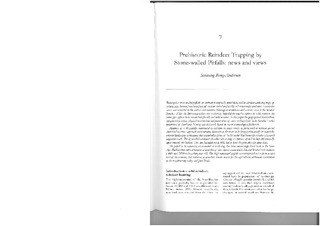| dc.contributor.author | Bang-Andersen, Sveinung | |
| dc.date.accessioned | 2012-08-20T13:20:02Z | |
| dc.date.available | 2012-08-20T13:20:02Z | |
| dc.date.issued | 2009 | |
| dc.identifier.citation | Bang-Andersen, S. (2009). Prehistoric reindeer trapping by stone-walled pitfalls: news and views. In: Finlay, N., McCartan, S., Milner, N. & Wickham-Jones, C. (Eds.). (2009). From Bann Flakes to Bushmills : papers in honour of Professor Peter Woodman (pp. 61-69). Oxford : Oxbow. | no_NO |
| dc.identifier.isbn | 978-1-84217-355-8 | |
| dc.identifier.issn | 2040-5049 | |
| dc.identifier.uri | http://hdl.handle.net/11250/181565 | |
| dc.description.abstract | Rectangular stone-walled pitfalls, in contrast to originally wood-clad, oval or circular earth-dug traps of varying size, known from large parts of interior central and northern Fennoscandia and some circumpolar areas, are restricted to the central and southern Norwegian mountains and a minor area in the Swedish Scandes. While the first constructions are exclusively intended for passive capture of wild reindeer, the latter type appear to be meant both for elk and wild reindeer. In this paper the geographical distribution,
topographical setting, physical construction and practical use of stone-walled pitfalls in the Setesdal Vesthei mountains of Southwest Norway are discussed, based on recent archaeological fieldwork.
Analyses of c. 60 pitfalls, constructed in isolation or, more rarely as pairs, with or without special
stone-built exterior approach constructions, demonstrate the traps to be lying systematically in waterside
oriented landscapes, or at locations that exploit other forms of 'bottle-necks' that funnel the reindeer's (extant) migration trails. The dry-walled catchment chambers are as long as a person, up to 2 m deep and normally taper towards the bottom. They are intended not to kill, but to keep the prey alive for some time.
No pitfall in Scandinavia, stone-walled or earth-dug, has been convincingly dated back to the Stone Age. Radiocarbon dates determine at least five of nine objects excavated in Setesdal Vesthei to be between c. 600 and 1800 radiocarbon years old. The 'high mountain' pitfalls are interpreted not to form a vital
part of the economy, but rather as a secondary income source for the agricultural settlements established in the neighbouring valley and fjord heads. | no_NO |
| dc.language.iso | eng | no_NO |
| dc.publisher | Oxbow Books | no_NO |
| dc.relation.ispartofseries | Prehistoric Society Research Papers;1 | |
| dc.subject | arkeologi | no_NO |
| dc.subject | jakt | no_NO |
| dc.title | Prehistoric reindeer trapping by stone-walled pitfalls: news and views | no_NO |
| dc.type | Journal article | no_NO |
| dc.type | Peer reviewed | no_NO |
| dc.subject.nsi | VDP::Humanities: 000::Archeology: 090::Nordic archeology: 091 | no_NO |
| dc.source.pagenumber | 61-69 | no_NO |
